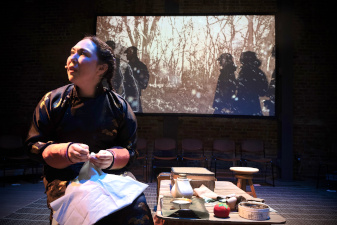
|
Beate Hein Bennett
Have Some Tea from Mongolia Those Who Remained
Sophia Gutchinov, the author and performer of “Those Who Remained” has delved deeply into her own mixed heritage of Kalmyk-Mongolian and Italian origins to retrieve the sources of her private being and public persona. Born in New Jersey and living in NYC, she is the very embodiment of the American immigrant experience—a child of transplants who come to this country, sometimes under helter-skelter circumstances, from all corners of the world for a myriad of reasons to find a refuge, build an existence, find a mate and create a family. The marital partnership may eventually succumb to tensions caused by widely divergent cultural values and misunderstanding, which in turn affect the children’s own sense of being, as they grow up aware of their mixed identities. Sometimes the children suffer from the social or racial prejudices that are thrown in their face. Since the question of racial self-identification is still a part of most bureaucratic categorizations—often by color, as in white or black, or by ethnicity as in Hispanic or Ashkenazi Jew, or by geography, as in Asian, or simply as Other(?), the question of how one categorizes or identifies oneself becomes part of growing into adulthood in the United States. (Until the 1950s, Asians had “yellow” as an identity marker in their official documents.) While this uniquely (but typical) multi-cultural, multi-ethnic American immigrant experience as an integral part of United States history has come under political attack, the counter-trend of identity politics has fragmented society into ever more self-isolating and adversarial interest groups. With her exploration into her global roots, Sophia Gutchinov pursues a different path, one that celebrates the many fragments of generational experiences that have become part of her genetically and culturally while at the same time fully embracing her ‘Americaness’ as an assertive urbane young woman living in this confused/confusing virtual/real world dominated by social media and its information/noise overload. While she is trained as a professional actor, she is also an activist for the Asian American Pacific Island [AAPI] movement. She has also done field research in Mongolia as well as in Peru to study the ecology, traditions and arts of indigenous cultures, and she spent time as resident artist with the Trinacria Theatre Co. in Pezzolo, Sicily and at LaMaMa’s Umbria Writing Workshop. In short, she has embraced the globe within herself to produce this work. Many collaborators for the production helped to create this multi-media solo performance. First and foremost is her Director and Scenic designer Rani O’Brien who has shaped the open space of The Club into an elliptical performance space with one central low table set with props. The audience is seated around the periphery—it creates an ambience suitable for the ritualistic aspects of the performance. Mounted on the two long walls behind the audience are projection screens where a variety of videos and projections amplify the actor’s narrative on stage, sometimes with realistic action shots like a home video, sometimes with abstract designs illustrating a historical event—all ingeniously composed by Projection Designer Luna Yixi Wu. As the audience enters, a drone sound-scape designed by Boris Nazarov subtly hints at the ritual that begins the performance. Sophia Gutchinov enters the stage space clad in a black Mongolian silk gown with gold ornamentation; she settles down at the low table and begins to pour tea with milk in a ceremonial manner—Mongolian tea, as she points out with her first line about how all is connected to the earth—humans, animals, and tea. (Before the performance the audience had been invited to help themselves to some tea set up in a corner.) From this reflective beginning she spins (sometimes literally) into her story.
The dramaturgical structure of her performance is a rapid succession of fragments of her American life and of her family’s ancestral roots and traumas. It is a stylistic structure of communication that resembles the shorthand of twittering or texting, so predominant among the younger generation but which does not encourage deeper reflection. She speaks mostly in her own voice but sometimes she alternates her voice with that of impersonated characters that have intimately touched her life. The text is a mélange of brief observations, fragments of remembered dialogues with an assortment of lovers, and historical information about the traumatic migrations of her Kalmyk people from Mongolia to Russia to Europe. A highlight in the performance is a shamanic invocation of the Earth Mother projected as an enlarged shadow of herself in a fantastic Love on Fire costume designed by Brynne Oster-Bainnson— a comic touch is the Earth Mother’s slight New Jersey twang. Much of the text is performed in a rapid-fire delivery with controlled choreographic movements. However, when she invokes her Kalmyk/Mongolian grandmother Lida, she centers herself into a calm realm, either seated at the low table, speaking quietly and simply. I would have liked more sustained moments like that because it would have allowed for more depth. Rani O’Brien writes in her Director’s Note about this “excavation” of identity: “Slipping between personal memoir, collective myth, and somatic memory, each shift seeks to expose the tension between permanence and flight, borders and movement, home and corporeality, self and community.” The performance of “Those Who Remained” opens many questions about one’s roots, about acceptance and survival. |
| recordings | coupons | publications | classified |

